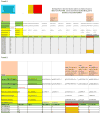Pharmacogenetic allele nomenclature: International workgroup recommendations for test result reporting
- PMID: 26479518
- PMCID: PMC4724253
- DOI: 10.1002/cpt.280
Pharmacogenetic allele nomenclature: International workgroup recommendations for test result reporting
Abstract
This article provides nomenclature recommendations developed by an international workgroup to increase transparency and standardization of pharmacogenetic (PGx) result reporting. Presently, sequence variants identified by PGx tests are described using different nomenclature systems. In addition, PGx analysis may detect different sets of variants for each gene, which can affect interpretation of results. This practice has caused confusion and may thereby impede the adoption of clinical PGx testing. Standardization is critical to move PGx forward.
Published 2015. This article is a U.S. Government work and is in the public domain in the USA.
Conflict of interest statement
• John Logan Black: Stock: AssureX, Oneome. Grants: NIH. Royalties: AssureX and Oneome. Patent for psychiatric pharmacogenomic selection algorithms licensed to AssureX.
• Carsten Bruckner: Employee of Affymetrix
• Andria L. Tredici: Employee of Millennium Health
• Robin Everts: Employee and option holder of Agena Bioscience
• Andrea Gaedigk: Paid consultant for Millennium Health
• Houda Hachad: Chief Science Officer at Translational Software, an interpretive service company. Own company’s Stock.
• Toinette Hartshorne: Employee of Thermo Fisher Scientific
• Teri E. Klein: Scientific Consultant Personalis Inc.
• Howard L. McLeod: Board of Directors, Cancer Genetics Inc
• Victoria M. Pratt: Employee of a fee for service clinical laboratory
• Mary V. Relling: Husband and hospital get royalties from TPMT genetic test.
• Ali Roberts: Employee of Aegis Sciences Corporation
• Stuart A. Scott: Receives support from NIH for antiplatelet pharmacogenomics research and is an Associate Director of a clinical laboratory that performs pharmacogenetic testing.
• Ranjit K Thirumaran: Employee of Genelex
• Lorraine H. Toji: Employed by the Coriell Institute for Medical Research
• Rachel Tyndale: Consulted for Apotex, associated editor for CPT
• Ulrich M. Zanger: Co-inventor on several patent applications
• All other authors reported no conflicts.
Figures



References
-
- Pirmohamed M. Personalized pharmacogenomics: predicting efficacy and adverse drug reactions. Annual review of genomics and human genetics. 2014;15:349–70. - PubMed
-
- Meyer UA. Pharmacogenetics - five decades of therapeutic lessons from genetic diversity. Nature reviews Genetics. 2004;5:669–76. - PubMed
-
- Huang SM, Temple R. Is this the drug or dose for you? Impact and consideration of ethnic factors in global drug development, regulatory review, and clinical practice. Clinical pharmacology and therapeutics. 2008;84:287–94. - PubMed
-
- Shah RR, Smith RL. Inflammation-induced phenoconversion of polymorphic drug metabolizing enzymes: hypothesis with implications for personalized medicine. Drug metabolism and disposition: the biological fate of chemicals. 2015;43:400–10. - PubMed
-
- Jones DS. How personalized medicine became genetic, and racial: Werner Kalow and the formations of pharmacogenetics. Journal of the history of medicine and allied sciences. 2013;68:1–48. - PubMed
Publication types
MeSH terms
Grants and funding
- U19 GM061388/GM/NIGMS NIH HHS/United States
- R01 GM088076/GM/NIGMS NIH HHS/United States
- R01 DA035736/DA/NIDA NIH HHS/United States
- U01HG007762/HG/NHGRI NIH HHS/United States
- P30 CA021765/CA/NCI NIH HHS/United States
- R24GM115264/GM/NIGMS NIH HHS/United States
- K23 GM104401/GM/NIGMS NIH HHS/United States
- CC999999/ImCDC/Intramural CDC HHS/United States
- 099129/Z/12/Z/WT_/Wellcome Trust/United Kingdom
- R24 GM61374/GM/NIGMS NIH HHS/United States
- U01 HG007762/HG/NHGRI NIH HHS/United States
- R24 GM061374/GM/NIGMS NIH HHS/United States
- 2 R01 GM088076-05/GM/NIGMS NIH HHS/United States
- U19 GM61388/GM/NIGMS NIH HHS/United States
- U41 HG003345/HG/NHGRI NIH HHS/United States
- R24 GM115264/GM/NIGMS NIH HHS/United States
- WT_/Wellcome Trust/United Kingdom
- U41HG003345/HG/NHGRI NIH HHS/United States
LinkOut - more resources
Full Text Sources
Other Literature Sources
Medical

